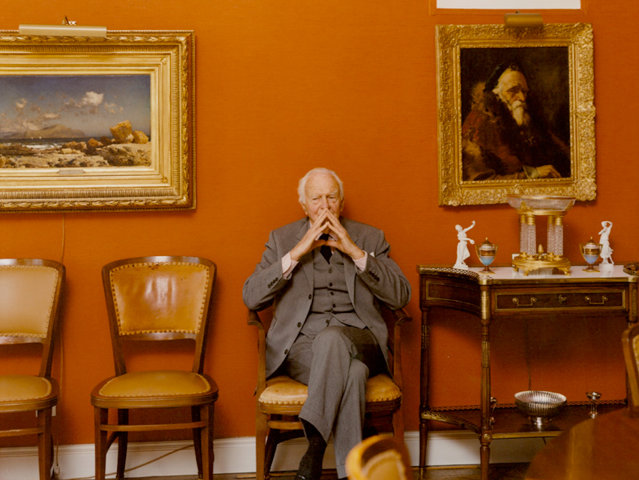There's a lot in a name sometimes. Other times it's what is not named that is surprising.
Take photographer Tina Barnes' work, for example. The nearly two dozen portraits in "The Europeans: Photographs by Tina Barney," which is on display now through May 20 at the Haggerty Museum of Art on the Marquette campus, are fairly straightfoward portraiture.
In one image, a nattily dressed older gentleman sits on a chair in what appears to be a comfortably upper class home. He is seated center-frame and is what most would consider the focal point of the photograph.
What's his name? We don't know. The title of the photograph is "The Orange Room, 1996." And immediately our focus shifts from the man to the orange wall behind him.
"The color of a room often has a sharper emotional pitch (in these photographs)," writes Richard B. Woodward in the show's catalog, "than the human beings who pose there."
We may think the three little girls and their parents are the "stars" in "The Daughters, 2002." But perhaps it is the elaborate tapestry that hangs behind them.
Are the two men and a dog the focal point in another image or is it the out of focus orchids of the work's title that are meant to draw our attention. Maybe Barney is balancing our natural tendency to focus on the person, by reminding us of other important aspects of an image.
Woodward also talks about Barney's ability to distract us or to direct our attention.
"She redefines the photographic portrait through her use of selective focus to ensure that specific elements of the image are clear and pristine, directing our attention in subtle and not-so-subtle ways to the sumptuous surroundings."
It's true. In "The Tapestry, 2003," the human subject stands in the foreground and with her chin lifted and her gaze stern, the woman should be the focal point of the image. But she's almost lost in the detail of the tapestry behind her. The fabric depicts a forest and the woman photographed is practically swallowed up by it. We can't see her for the trees.
The panels tell us very little about the photos. We don't know who these people are. Often we don't know how they are related, when there is more than one figure pictured. We can guess they are European, but in nearly every case, the country remains unidentified.
What we can tell about them all is that they look at least relatively well-heeled. But I'm even leery of making that assumption. And perhaps rightly so, according to Richard B. Woodward, who penned the catalog essay.
"Given the deceptive realism of photography," he writes, "so-called truths that within a wider context turn out to be unsupported assumptions, we have to accept the possibility that our eyes are leading us astray. The clues that Barney drops about her subjects don't lead us very far and, more likely than not, we're headed down the wrong trail."
Despite the potential to wander down dead-end trails lined with incorrect assumptions, it sure is fun to gaze upon these figures and into their homes and see where our eyes and minds lead us.
Born in Brooklyn, N.Y., where he lived until he was 17, Bobby received his BA-Mass Communications from UWM in 1989 and has lived in Walker's Point, Bay View, Enderis Park, South Milwaukee and on the East Side.
He has published three non-fiction books in Italy – including one about an event in Milwaukee history, which was published in the U.S. in autumn 2010. Four more books, all about Milwaukee, have been published by The History Press.
With his most recent band, The Yell Leaders, Bobby released four LPs and had a songs featured in episodes of TV's "Party of Five" and "Dawson's Creek," and films in Japan, South America and the U.S. The Yell Leaders were named the best unsigned band in their region by VH-1 as part of its Rock Across America 1998 Tour. Most recently, the band contributed tracks to a UK vinyl/CD tribute to the Redskins and collaborated on a track with Italian novelist Enrico Remmert.
He's produced three installments of the "OMCD" series of local music compilations for OnMilwaukee.com and in 2007 produced a CD of Italian music and poetry.
In 2005, he was awarded the City of Asti's (Italy) Journalism Prize for his work focusing on that area. He has also won awards from the Milwaukee Press Club.
He has be heard on 88Nine Radio Milwaukee talking about his "Urban Spelunking" series of stories, in that station's most popular podcast.







